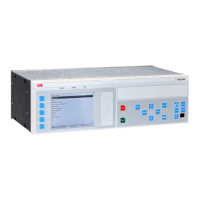Disturbance report function can handle maximum 3 simultaneous disturbance recordings.
12.4.7 Technical data
Table 390: DRPRDRE technical data
Function
Range or value Accuracy
Current recording - ± 1,0% of I
r
at I ≤ I
r
± 1,0% of I at I > Ir
Voltage recording - ± 1,0% of V
n
at V≤ V
n
± 1,0% of Vat V> V
n
Pre-fault time (0.05–3.00) s -
Post-fault time (0.1–10.0) s -
Limit time (0.5–8.0) s -
Maximum number of recordings 100, first in - first out -
Time tagging resolution 1 ms See time synchronization
technical data
Maximum number of analog inputs 30 + 10 (external + internally
derived)
-
Maximum number of binary inputs 96 -
Maximum number of phasors in the Trip
Value recorder per recording
30 -
Maximum number of indications in a
disturbance report
96 -
Maximum number of events in the Event
recording per recording
150 -
Maximum number of events in the
Sequence of events
1000, first in - first out -
Maximum total recording time (3.4 s
recording time and maximum number of
channels, typical value)
340 seconds (100 recordings) at
50 Hz, 280 seconds (80
recordings) at 60 Hz
-
Sampling rate 1 kHz at 50 Hz
1.2 kHz at 60 Hz
-
Recording bandwidth (5-300) Hz -
12.5 Indications
12.5.1 Functionality
To get fast, condensed and reliable information about disturbances in the primary and/or
in the secondary system it is important to know, for example binary signals that have
Section 12 1MRK 511 287-UUS A
Monitoring
488
Technical manual

